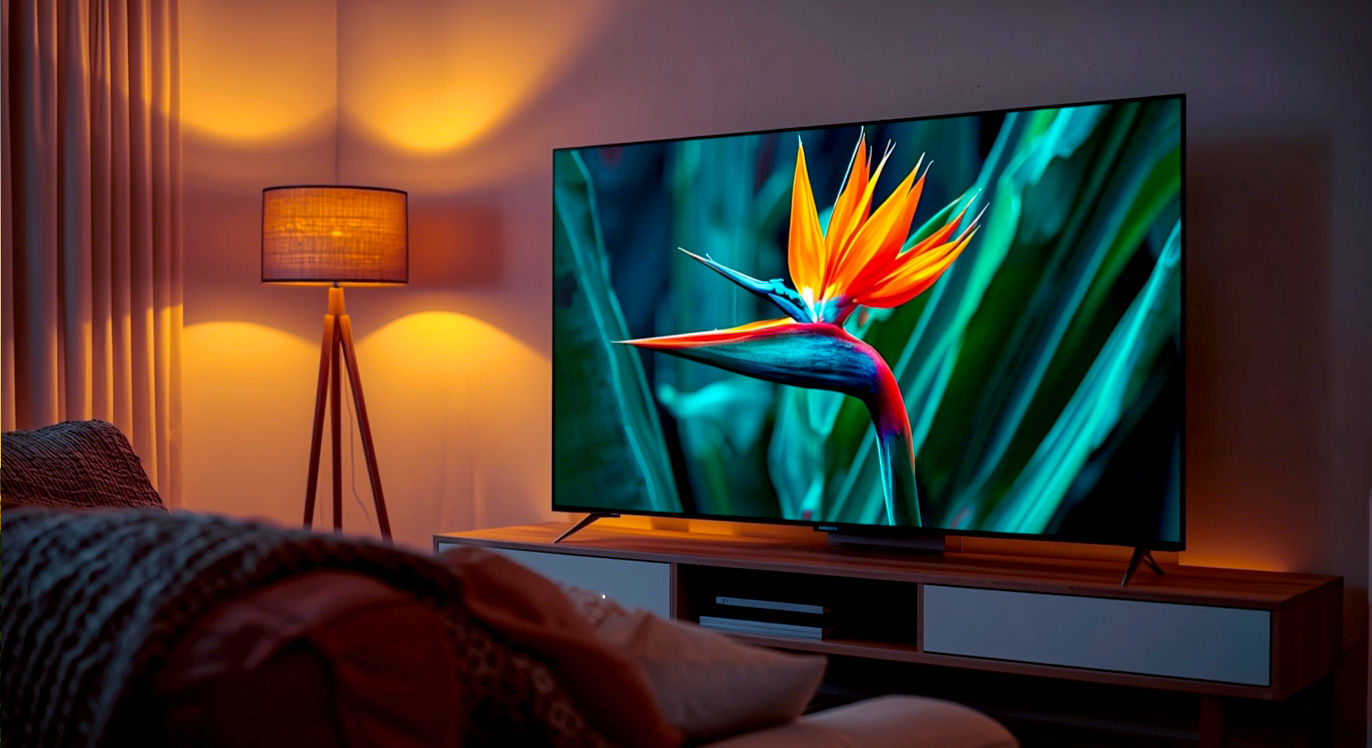The Guide to 4K TVs: Everything You Need to Know for the Perfect Picture
Everything you need to know about 4K TVs in one place. This ultimate guide breaks down the tech, explains the jargon, and offers practical advice for UK buyers.

This post may contain affiliate links. If you make a purchase through these links, we may earn a commission at no additional cost to you.
It wasn’t so long ago that the idea of having a cinema-quality picture in your living room felt like something out of a sci-fi film. We were all perfectly happy with our chunky CRT tellies, blissfully unaware of the crystal-clear revolution heading our way. Then came HD, and suddenly we could see the blades of grass on the pitch at Wembley and the individual sequins on a Strictly dancer’s costume. We thought that was it – the peak of television. We were wrong.
Enter 4K Ultra HD, a leap in picture quality so significant it changed the game all over again. Suddenly, every scene became more immersive, every detail sharper, and every colour more vibrant. It’s like going from a standard pair of glasses to a prescription that’s perfectly tailored to your eyes. But what exactly is 4K? Is it just more pixels, or is there more to it? And with all the jargon flying around – HDR, OLED, QLED, refresh rates – how do you choose the right one for your home without needing a degree in electrical engineering?
This guide is here to cut through the noise. We’ll break down everything you need to know about 4K TVs, from the basic tech to the fancy features that actually make a difference. We’ll explore how this technology came to be, its impact on how we watch everything from Sir David Attenborough’s latest documentary to the nail-biting final of The Great British Bake Off, and give you the practical advice you need to buy the best 4K TV for your budget and your living room. So, grab a cuppa, settle in, and let’s demystify the world of 4K.
What on Earth is 4K? The Simple Explanation
Before we dive into the deep end, let’s get the basics sorted. What does “4K” actually mean?
At its core, 4K refers to the resolution of the screen. Think of your TV screen as a massive grid made up of tiny little dots called pixels. Each pixel is a tiny light that can change colour. When you put millions of them together, they create the image you see. The more pixels you have, the sharper and more detailed the picture will be.
A standard High Definition (HD) TV, which you might also hear called 1080p, has a resolution of 1920 pixels across and 1080 pixels down. If you do the maths (1920 x 1080), that’s just over 2 million pixels in total.
A 4K TV, also known as Ultra High Definition (UHD), quadruples that. It has a resolution of 3840 pixels across and 2160 pixels down. That works out to a staggering 8.3 million pixels.
So, What Does That Actually Look Like?
Imagine you’re painting a picture using a mosaic of tiny coloured tiles. With an HD TV, you have 2 million tiles to work with. You can create a pretty good image, but if you look closely, you might see the edges of the tiles. With a 4K TV, you have over 8 million tiles. The tiles are much smaller and packed closer together, allowing you to create a picture that’s incredibly smooth, sharp, and lifelike. You won’t see the individual pixels, just a seamless, stunning image.
This huge increase in pixel density means you can see far more detail. In a nature documentary, you can see the individual hairs on a lion’s mane. In a football match, the crowd is no longer a blurry mass but a collection of individual faces. It makes everything feel more real, drawing you into the action in a way that just wasn’t possible before.
It also means you can have a much larger TV without the picture looking blocky or fuzzy. Because the pixels are so small, you can sit closer to a big 65-inch 4K screen than you could to an old HD one of the same size and still get a perfect, crisp image. This has completely changed how we think about the telly’s place in the British living room; it’s no longer just a box in the corner but a proper centrepiece for home entertainment.
More Than Just Pixels: The Magic of HDR
While 4K resolution is the headline feature, it’s only half the story. The real secret sauce that makes modern TVs look so incredible is High Dynamic Range, or HDR. If 4K gives you more pixels, HDR makes every single one of those pixels better.
What is HDR?
Dynamic range is the difference between the darkest part of an image and the brightest part. A standard TV has a limited dynamic range, which means it can struggle to show detail in very dark or very bright scenes. For example, in a film where a character is hiding in a dark alley at night, a standard TV might just show a block of black, losing all the subtle details in the shadows. Similarly, a bright, sunny sky might look like a flat sheet of white, with the clouds completely blown out.
HDR dramatically expands this range. It allows for brighter whites, deeper blacks, and a much wider range of colours in between.
Let’s break that down:
- Brighter Highlights: HDR allows parts of the screen to get much brighter than on a standard TV. This isn’t about making the whole picture blindingly bright, but about adding realistic pops of light. Think of the glint of sunlight on a car, the flicker of a candle, or the explosion in an action movie. These highlights look incredibly punchy and realistic.
- Deeper Blacks: It also allows for much darker, inkier blacks. This is crucial for creating contrast, which is the difference between light and dark. Better contrast makes the image pop and gives it a sense of depth, making it look more three-dimensional.
- A World of Colour: HDR also supports a wider colour gamut. This means it can display billions of colours, far more than the millions on a standard TV. This allows for more subtle and realistic shades. A field of grass isn’t just green; it’s a hundred different shades of green, from lime to emerald. A sunset isn’t just a band of orange; it’s a beautiful gradient of reds, purples, and yellows.
When you combine 4K resolution with HDR, the result is breathtaking. It’s a picture that’s not only sharp but also vibrant, punchy, and incredibly lifelike. It’s the closest you can get to looking through a window rather than at a screen.
The Different Flavours of HDR: A Quick Guide
To make things a little more complicated, HDR isn’t just one single thing. There are a few different formats, and the one your TV supports can make a difference.
- HDR10: This is the most common, open-standard format. Nearly every HDR TV supports it, and it’s used by most streaming services and 4K Blu-rays. It’s a great baseline for a fantastic HDR experience.
- Dolby Vision: This is a more advanced HDR format. The main difference is that it uses “dynamic metadata,” which sounds complicated but is actually quite simple. It means the brightness and colour levels can be adjusted scene-by-scene, or even frame-by-frame, to make sure the picture is always optimised. It often looks a bit more refined and accurate than HDR10. Streaming giants like Netflix and Disney+ are big fans of Dolby Vision.
- HDR10+: This is a rival format to Dolby Vision, backed by companies like Samsung and Amazon Prime Video. It also uses dynamic metadata, like Dolby Vision, to optimise the picture on the fly.
- HLG (Hybrid Log-Gamma): This one is particularly important for us in the UK. It was co-developed by the BBC and Japanese broadcaster NHK specifically for live broadcasts. It allows broadcasters to send a single signal that works on both HDR and non-HDR TVs, which is much more efficient. This is the format the BBC uses for its 4K HDR content on iPlayer, like Planet Earth and Wimbledon.
When you’re buying a new TV, it’s worth checking which of these formats it supports. Most high-end TVs will support several of them, giving you the best possible picture no matter what you’re watching.
The Journey to 4K: A Brief History of the Telly
The telly has been the heart of the British home for generations, from watching the Queen’s coronation in black and white to gathering the family for the Christmas special of Doctor Who. The journey from those flickering early sets to the ultra-sharp 4K screens of today is a fascinating story of British innovation and global technological leaps.
From Analogue Fuzz to Digital Clarity
For decades, television was broadcast as an analogue signal. The picture was fuzzy by today’s standards, with a low resolution often referred to as 480i or 576i. This was the era of the big, boxy CRT (cathode-ray tube) TV. Here in the UK, the switch from black and white to colour began with BBC2 in 1967, a landmark moment that brought programmes to life in a whole new way.
The first big shake-up of the modern era was the move to digital television. This process began in the late 1990s and culminated in the UK’s digital switchover, which was completed in 2012. Digital TV brought us widescreen pictures as standard and a clearer, more stable image. This paved the way for the first flat-screen TVs – plasma and LCD screens – which started to replace our old CRT sets.
The HD Revolution
The next giant leap was High Definition (HD). The BBC began HD trials in 2006, and Sky launched its HD service in the same year. For the first time, we could watch programmes with a level of detail that was simply astounding. The standard HD resolutions were 720p and, more commonly, 1080p (‘Full HD’). This 1920×1080 resolution, with its 2 million pixels, became the gold standard for over a decade. It transformed sports, nature documentaries, and blockbuster films, making them more immersive than ever.
The Dawn of 4K
The idea of ‘Ultra High Definition’ had been bubbling away in tech labs for years, but it was in the early 2010s that 4K started to become a reality for consumers. The first 4K TVs were eye-wateringly expensive, costing tens of thousands of pounds. There was also very little to watch in 4K. It was a classic chicken-and-egg situation: nobody wanted to buy a 4K TV without 4K content, and nobody wanted to make 4K content without a 4K audience.
The breakthrough came from streaming services. Netflix began streaming some of its original shows, like House of Cards, in 4K in 2014. This was a game-changer. Suddenly, there was a reason to own a 4K TV. Amazon Prime Video and YouTube quickly followed suit.
In the UK, broadcasters were a little slower to adopt the new format. BT Sport was an early pioneer, launching a 4K sports channel in 2015. Sky followed with Sky Q in 2016, offering Premier League football, films, and entertainment in stunning UHD. And, of course, the BBC began streaming landmark events and its world-class natural history programmes in 4K HDR on iPlayer.
Today, 4K is the new standard. The price of 4K TVs has tumbled, making them affordable for almost everyone. There’s a vast library of 4K content available at our fingertips, from the latest Hollywood blockbusters to binge-worthy box sets. It’s been a remarkable journey from the fuzzy screens of the past to the pin-sharp clarity we now enjoy.
The Panel Battle: LED, QLED, and OLED Explained
When you start shopping for a 4K TV, you’ll quickly run into a confusing alphabet soup of acronyms: LED, QLED, OLED. These refer to the different types of screen technology, or ‘panels’, that TVs use. This is probably the single biggest factor that determines a TV’s picture quality and its price, so it’s important to understand the difference.
LED TVs (and a Note on “QLED”)
The vast majority of TVs on the market today are LED TVs. Technically, they are LCD TVs that use LEDs (Light Emitting Diodes) as their backlight.
Here’s how it works:
- There’s a big light source at the back of the TV (the LED backlight).
- In front of that, there’s a layer of liquid crystals (the LCD panel).
- These crystals act like tiny shutters, opening and closing to let light through or block it.
- In front of that, there’s a colour filter that turns the white light into the red, green, and blue that make up the final image.
LED TVs are brilliant all-rounders. They can get very bright, which makes them great for watching in a well-lit room, and they are the most affordable type of TV technology.
However, they have one main weakness: black levels. Because they rely on a backlight that is always on, it’s very difficult for them to produce a true, deep black. The LCD shutters can’t block 100% of the light, so in a dark scene, you’ll often see a faint grey glow instead of pure black.
To improve this, TV makers have developed technologies like Micro Dimming or Local Dimming. This divides the backlight into different zones that can be dimmed or brightened independently. It helps to improve contrast, but it’s not a perfect solution and can sometimes create a ‘halo’ effect around bright objects on a dark background.
What about QLED? You’ll see brands like Samsung and TCL marketing their high-end LED TVs as QLED. This is still an LED TV at its heart, but it has an extra layer of tiny particles called ‘quantum dots’. These dots glow when light hits them, allowing the TV to produce a much wider and more accurate range of colours. QLED TVs are known for their incredibly bright and vibrant pictures, making them fantastic for HDR content. They represent the peak of what LED technology can do.
OLED TVs: The King of Contrast
OLED (Organic Light Emitting Diode) technology works in a completely different way. With an OLED TV, each individual pixel creates its own light. There is no backlight.
This is a massive advantage. To create black, an OLED pixel simply switches itself off completely. No light, no glow – just perfect, absolute black. This ability to control the light at the pixel level gives OLED TVs what’s called ‘infinite contrast’.
The result is a picture with incredible depth and realism. Colours pop against the inky black background, and details in dark scenes are perfectly preserved. Because there’s no backlight, OLED TVs can also be incredibly thin, often just a few millimetres thick. They also have fantastic viewing angles, meaning the picture looks great no matter where you’re sitting in the room.
So, are there any downsides? Well, they can be more expensive than their LED counterparts. They also can’t get quite as bright as the best QLED TVs, which might be a consideration if you watch a lot of telly in a very bright, sun-drenched room. There’s also a theoretical risk of ‘burn-in’, where a static image (like a channel logo) could permanently mark the screen if left on for hundreds of hours, though modern OLEDs have lots of clever tech to prevent this from being an issue for most people.
Which One is Right for You?
- LED: The best choice for most people on a budget. Modern LED TVs offer fantastic 4K HDR picture quality at a great price.
- QLED: A great option if you have a bright living room and you love a punchy, vibrant picture. They offer a premium experience without the premium price tag of OLED.
- OLED: The ultimate choice for film lovers and picture quality purists. If you do most of your viewing in the evening in a dimly lit room, the perfect blacks and infinite contrast of OLED are simply unbeatable.
Making Sense of the Specs: What Really Matters?
When you look at a TV’s product page, you’ll be bombarded with technical specifications. It’s easy to get lost in the numbers, but only a few of them really make a tangible difference to your viewing experience. Let’s focus on the important ones.
Refresh Rate: Smooth Motion for Sport and Gaming
The refresh rate, measured in Hertz (Hz), tells you how many times per second the image on the screen is updated. The standard refresh rate for TVs in the UK is 50Hz, but you’ll often see TVs advertised with 60Hz or even 100/120Hz panels.
A higher refresh rate allows for smoother, clearer motion. This is most noticeable in fast-paced content like sports and video games. On a 50/60Hz TV, a fast-moving football can sometimes appear to judder or blur slightly. On a 100/120Hz TV, the motion is much smoother and sharper, making it easier to follow the action.
For general TV and film watching, a 50/60Hz panel is absolutely fine. But if you’re a big sports fan or a keen gamer, it’s definitely worth investing in a TV with a 100/120Hz refresh rate.
You’ll also see manufacturers use terms like “Motion Clarity” or other branded phrases with much higher numbers (e.g., 400Hz). This usually refers to software-based motion processing, which inserts extra frames into the picture to make it look smoother. It can be effective, but it can also create a strange, ultra-smooth look known as the ‘soap opera effect’, which many people dislike for films. The important number to look for is the ‘native’ refresh rate of the panel itself (60Hz or 120Hz).
Smart TV Platforms: Your Gateway to Content
Nearly every new TV is a ‘Smart TV’, which simply means it can connect to the internet and run apps. This is how you’ll access services like Netflix, BBC iPlayer, Prime Video, and Disney+. The smart platform is the TV’s operating system, and a good one can make a huge difference to how easy and enjoyable your TV is to use.
Here are some of the main players in the UK:
- Android TV / Google TV: Used by brands like Sony, Philips, and TCL, this is a powerful and flexible platform. It has a huge selection of apps available through the Google Play Store and has Google Assistant and Chromecast built-in. Google TV is the newer, more user-friendly version, with a focus on recommending content from across all your different services.
- Fire TV: This is Amazon’s smart TV platform, found on some models from brands like TCL. If you’ve ever used an Amazon Fire TV Stick, you’ll feel right at home. It’s simple to use and has excellent Alexa voice control integration.
- Freeview Play: This isn’t a full operating system in itself, but a brilliant UK-specific feature that’s built into most smart platforms. It integrates all the catch-up TV services from the main UK broadcasters (BBC iPlayer, ITVX, All 4, My5) directly into the TV guide. This means you can simply scroll back through the guide and click on a programme you missed to start streaming it instantly. It’s a must-have feature for any UK TV.
When choosing a TV, it’s worth thinking about which platform you’d prefer. A good smart system should be fast, easy to navigate, and have all the apps you use regularly.
Connections: Getting Your Kit Hooked Up
Finally, don’t forget to check the back of the TV. The most important connection is HDMI. This is how you’ll connect things like a Sky box, a Blu-ray player, or a games console.
Most TVs come with three or four HDMI ports, which is usually plenty. The key thing to look for, especially if you’re a gamer, is support for HDMI 2.1. This is the latest version of the standard and it’s essential for getting the most out of the latest consoles like the PlayStation 5 and Xbox Series X. HDMI 2.1 supports features like 4K gaming at 120Hz and ALLM (Auto Low Latency Mode), which automatically switches the TV to its gaming mode to reduce input lag.
Buying Your Perfect 4K TV: A Practical Checklist
You’ve done the research, you understand the tech, and now you’re ready to buy. Here’s a simple checklist to help you make the right choice.
- What’s Your Budget? 4K TVs range from a few hundred pounds to several thousand. Set a realistic budget before you start. The good news is that you can get a fantastic 4K HDR TV for under £500 these days. As you spend more, you’ll generally get better picture quality (e.g., moving from LED to QLED or OLED), more advanced features, and better design.
- What Size Do You Need? This depends on the size of your room and how far away you’ll be sitting. Thanks to 4K resolution, you can go bigger than you might think. A 55-inch TV is now the most popular size in the UK, and 65-inch models are becoming increasingly common. A good rule of thumb is to measure the distance from your sofa to where the TV will be (in inches) and divide it by two. The result is a good starting point for the ideal screen size.
- Where Will It Go? Think about the lighting in your room. If you have a very bright room with lots of windows, a bright QLED TV might be a better choice than an OLED, which performs at its best in darker environments.
- What Will You Be Watching?
- Film Buff? An OLED TV is your best bet for that true cinematic experience, thanks to its perfect blacks and stunning contrast.
- Sports Fan? Look for a TV with a 100/120Hz native refresh rate for the smoothest motion.
- Gamer? Make sure the TV has HDMI 2.1 ports and features like ALLM (Auto Low Latency Mode) and VRR (Variable Refresh Rate) for the best gaming performance.
- Don’t Forget the Sound! As TVs have gotten thinner, there’s less room for good quality built-in speakers. While the sound on modern TVs is perfectly acceptable for day-to-day viewing, it often lacks the punch and clarity to match the stunning 4K picture. To get a truly immersive, cinematic experience, it’s well worth investing in a soundbar. Even a budget-friendly soundbar will be a massive upgrade over the TV’s own speakers, delivering clearer dialogue and more impactful sound effects. Many TVs now support Dolby Audio or even the more advanced Dolby Atmos, which can create an amazing 3D surround sound effect when paired with a compatible soundbar.
The Future is Bright (and Even Sharper)
The world of television tech never stands still. While 4K is the standard today, the next generation of technology is already here. 8K TVs, with a mind-boggling 33 million pixels, are now available to buy.
Right now, there’s virtually no native 8K content to watch, and the difference in detail over 4K is only really noticeable on enormous screens. However, 8K TVs often have the most powerful processors, which can do an amazing job of ‘upscaling’ 4K and HD content to look sharper and cleaner. For most of us, 4K is the sensible choice for now, but 8K gives us a glimpse of where things are heading.
We’re also seeing Artificial Intelligence (AI) play a bigger role. TV processors are getting smarter, using AI to analyse the picture in real-time and optimise the brightness, contrast, and colour for any scene. This AI-powered upscaling is getting so good that it can make a good quality HD source look almost as sharp as native 4K.
From the first fuzzy black and white broadcasts to the AI-enhanced 8K screens of tomorrow, the television has been on an incredible journey. But today, in 2025, we are in the golden age of television technology. 4K HDR offers a stunning, immersive, and, most importantly, affordable viewing experience. It has fundamentally changed the way we enjoy our favourite films, shows, and sports, bringing the magic of the big screen right into our living rooms. So, whether you’re settling down for a Saturday night movie or cheering on your team, the future of television looks absolutely brilliant.
Further Reading
To continue your research, we recommend these highly respected resources in the home entertainment niche:
- What Hi-Fi?: A brilliant UK-based publication offering expert reviews, news, and advice on TVs, audio, and all things home cinema.
- AVForums: An incredibly knowledgeable community of home cinema enthusiasts and experts. The forums are a fantastic place to ask questions and get advice from real users.
- RTINGS.com: While a North American site, their in-depth, technical TV reviews and side-by-side comparisons are second to none. A valuable resource for detailed performance data.






